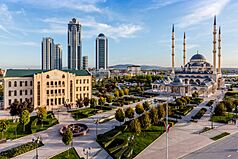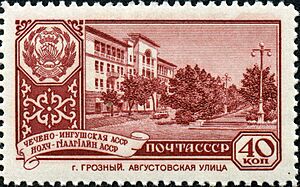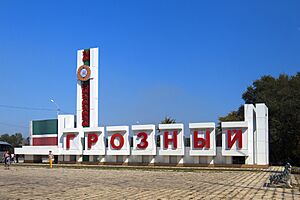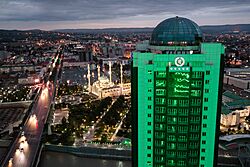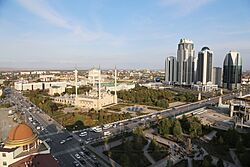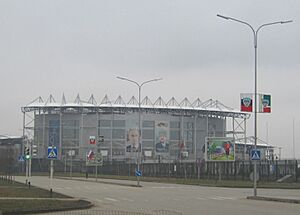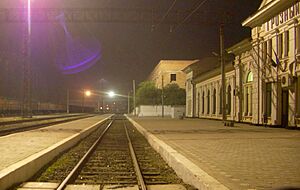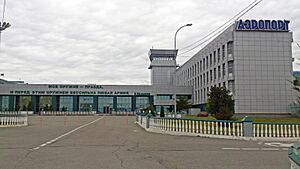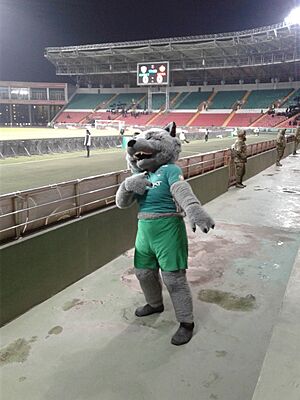Grozny facts for kids
Quick facts for kids Grozny (English)Грозный (Russian) Соьлжа-ГӀала (Chechen) |
|
|---|---|
| - City - | |
| [[File:
Clockwise from the top, Kadyrov Square, Grozny City Towers at night, Vaynakh School of Dance, National Museum of the Chechen Republic, The Courtyard of Akhmad Kadyrov Mosque at night
|
|
|
|
|
| City Day | October 5 |
| Administrative status | |
| Country | Russia |
| Federal subject | Chechen Republic |
| Administratively subordinated to | city of republic significance of Grozny |
| Capital of | Chechen Republic |
| Municipal status | |
| Urban okrug | Grozny Urban Okrug |
| Mayor | Khas-Magomed Kadyrov |
| Representative body | Council of Deputies |
| Statistics | |
| Area | 324.16 km2 (125.16 sq mi) |
| Population (2023 est.) | 331,402 inhabitants |
| Time zone | MSK (UTC+04:00) |
| Founded | 1818 |
| City status since | 1869 |
| Postal code(s) | 364000, 364001, 364006, 364008, 364011, 364013–364018, 364020–364022, 364024, 364028–364031, 364034, 364035, 364037, 364038, 364040, 364042, 364043, 364046, 364047, 364049, 364051, 364052, 364058, 364060–364063, 364066, 364068, 364700, 366000 |
| Dialing code(s) | +7 8712 |
| [grozmer.ru Official website] | |
Grozny (Russian: Грозный, IPA: [ˈgroznɨj]; Chechen: Соьлжа-ГӀала, romanized: Sölƶa-Ġala) is the capital city of Chechnya, a republic within Russia. It is located on the Sunzha River.
In 2021, the city had a population of over 328,000 people. Grozny has been rebuilt and modernized after facing significant challenges in its history.
Contents
Understanding the Name of Grozny
The name "Grozny" comes from the Russian language and means "fearsome" or "menacing." It's the same word used in the name of the famous Russian ruler, Ivan the Terrible (Ivan Grozny).
In the Chechen language, the city is often called "Соьлжа-Гӏала" (Sölƶa-Ġala). This name literally means "the city on the Sunzha River."
Temporary Names for Grozny
During the First Chechen War in 1996, the local government tried to rename the city Dzhokhar-Ghala. This meant "Dzhokhar City" and was named after Dzhokhar Dudayev, who was the first president of the Chechen Republic of Ichkeria.
Later, in 2005, there was a suggestion to rename the city "Akhmad-Kala," after Akhmad Kadyrov. However, his son, Ramzan Kadyrov, who became a leader in Chechnya, did not agree to this change.
A Brief History of Grozny
How Grozny Began: A Russian Fort
The city started as a Russian military fort called Groznaya in 1818. A general named Aleksey Petrovich Yermolov built it on the Sunzha River. The name "Groznaya" also meant "fearsome," like the city's current name.
The fort was an important defense spot during the Caucasian War. Many famous Russian writers and poets, like Leo Tolstoy, visited the fort.
In 1870, the fort became a town and was officially renamed Grozny. At first, it grew slowly. But in the early 1900s, large amounts of oil were discovered nearby. This discovery helped the town grow quickly. Important people like Alfred Nobel (who created the Nobel Prize) and the Rothschild family helped develop the oil industry here. British companies also played a big role. Grozny became a major center for oil production and industry in the Caucasus region.
Grozny as a Soviet Capital
After the October Revolution in 1917, Grozny became part of the new Soviet system. It was made the administrative center of the Chechen Autonomous Oblast in 1922.
At this time, many people living in Grozny were Russians. However, the Soviet government encouraged Chechens from the mountains to move into the city. In 1934, the Chechen-Ingush Autonomous Oblast was formed, which later became the Chechen-Ingush ASSR.
During World War II, Grozny was a very important target for Germany because of its oil. The city's oil fields were crucial for the war effort. Germany tried to capture Grozny in 1942 but failed. This failure was a big setback for them.
In 1944, a difficult period began for the Chechen and Ingush people. They were forced to leave their homes and were sent to other parts of the Soviet Union. Many people suffered and died during this time. All signs of their culture in the city, like books and graveyards, were destroyed. The European Parliament later recognized this event as an act of genocide in 2004.
Grozny then became a Russian city. But in 1957, the Chechen-Ingush ASSR was brought back, and the Chechens were allowed to return home. This led to some social challenges as people returned to a city that had changed a lot.
During the Soviet era, Grozny saw a lot of development. Many buildings were constructed in the Stalinist style, including apartments and government buildings. The city also got a university and an airport. By 1989, nearly 400,000 people lived in Grozny.
Grozny After the Soviet Union
After the Soviet Union broke apart, Grozny became the center of a government that wanted to be separate from Russia. Many Russian residents left the city during this time.
There were several attempts to take control of the city. In 1994, Russian forces tried to enter Grozny, but they were stopped. This led to a major conflict.
The First Chechen War in Grozny
From December 1994 to February 1995, Grozny was the site of a very intense battle during the First Chechen War. Much of the city was destroyed by heavy fighting and bombing. Thousands of people, including soldiers and civilians, lost their lives.
Chechen fighters used guerrilla tactics from the nearby mountains to fight the Russian army. In August 1996, these fighters surprised the Russian forces and recaptured the city. This battle led to a ceasefire, and Grozny was again controlled by Chechen separatists. The city's name was changed to Djohar in 1997.
The Second Chechen War in Grozny
Grozny became a battleground again when the Second Chechen War started. This war also caused many deaths. In October 1999, Russian forces launched missiles at a busy market and a hospital, killing many people.
The city was heavily shelled, causing massive damage to buildings. In February 2000, Russian forces took control of the city. Many buildings were systematically destroyed. In 2003, the United Nations called Grozny the most destroyed city on Earth, with almost no building left undamaged.
Grozny After the Wars: Rebuilding and Growth
Since 2003, Grozny has been rebuilt almost completely. Many of the city's systems, like sewage, water, electricity, and heating, have been repaired. Roads, bridges, and shops have also been rebuilt.
The Railway connection was restored in 2005. Grozny Airport reopened in 2007 and received international certification in 2009.
One of the most famous new buildings is the Akhmad Kadyrov Mosque, which opened in 2008. It is one of the largest mosques in Europe. In 2009, the United Nations Human Settlements Programme praised Grozny for its amazing transformation and for providing new homes for thousands of people.
City Structure and Administration
Grozny is the capital of the Chechen Republic. It is divided into four main city districts: Akhmatovsky, Baysangurovsky, Visaitovsky, and Sheikh-Mansurovsky.
Culture and Education in Grozny
Grozny is known for its modern architecture. Even though much of the city was damaged in the wars, it has been fully rebuilt.
The city is home to Chechen State University and Chechen State Pedagogical Institute. It also has the Grozny State Oil Technical University, which is important for studying oil and gas.
Grozny is also home to the football club FC Akhmat Grozny. The team plays in the Russian Football Premier League at the Akhmat Stadium.
Transportation in Grozny
Train Travel
The first train arrived at Grozny Railway station in 1893. Train connections were restored in 2005 after the wars.
Trams and Trolleybuses (Past)
Grozny used to have a tram system, which opened in 1932. It also had a trolleybus system, which started in 1975. Both systems stopped working during the First Chechen War in 1994.
During the fighting, the tram tracks were damaged, and the vehicles were used as barricades. While the trolleybus system's equipment mostly survived, much of it was later stolen. After the Second Chechen War, these public transport systems were not rebuilt because of the high cost and changes in the city's needs.
Airport Access
The city is served by Grozny Airport, which offers flights to other cities.
Modern Sharing Systems
In 2018, a car-sharing company called Delimobil started offering cars for rent in Grozny. Users can book these cars using a special app. In the same year, Delisamokat introduced electric scooters for sharing around the city.
Sports in Grozny
Grozny is home to the professional football club FC Akhmat Grozny. The team plays in the top Russian football league. They play their home games at the modern Akhmat Stadium.
The city also has the Fort Grozny motor racing circuit, which opened in 2015 for car racing events.
Geography and Climate of Grozny
Grozny is located along the Sunzha River, which flows into the Terek River. The city sits in a valley about 80 kilometers (50 miles) north of the main Caucasus Mountains.
Grozny's Weather
Grozny has a humid continental climate. This means it has hot summers and cold winters. The most rain falls during early summer, which is also when the city gets the most sunshine.
| Climate data for Grozny (1991–2020 normals, extremes 1938–present) | |||||||||||||
|---|---|---|---|---|---|---|---|---|---|---|---|---|---|
| Month | Jan | Feb | Mar | Apr | May | Jun | Jul | Aug | Sep | Oct | Nov | Dec | Year |
| Record high °C (°F) | 15.7 (60.3) |
22.3 (72.1) |
32.9 (91.2) |
33.7 (92.7) |
38.1 (100.6) |
39.1 (102.4) |
42.0 (107.6) |
41.4 (106.5) |
40.7 (105.3) |
32.5 (90.5) |
23.7 (74.7) |
20.2 (68.4) |
42.0 (107.6) |
| Mean daily maximum °C (°F) | 2.3 (36.1) |
3.7 (38.7) |
10.1 (50.2) |
17.3 (63.1) |
23.2 (73.8) |
28.2 (82.8) |
30.8 (87.4) |
30.6 (87.1) |
25.1 (77.2) |
17.2 (63.0) |
8.8 (47.8) |
3.5 (38.3) |
16.7 (62.1) |
| Daily mean °C (°F) | −1.5 (29.3) |
−0.6 (30.9) |
4.7 (40.5) |
10.8 (51.4) |
16.7 (62.1) |
21.4 (70.5) |
23.9 (75.0) |
23.6 (74.5) |
18.5 (65.3) |
11.6 (52.9) |
4.5 (40.1) |
0.1 (32.2) |
11.1 (52.0) |
| Mean daily minimum °C (°F) | −4.2 (24.4) |
−3.7 (25.3) |
0.8 (33.4) |
5.7 (42.3) |
11.5 (52.7) |
15.9 (60.6) |
18.2 (64.8) |
17.9 (64.2) |
13.4 (56.1) |
7.3 (45.1) |
1.4 (34.5) |
−2.5 (27.5) |
6.8 (44.2) |
| Record low °C (°F) | −31.5 (−24.7) |
−30.8 (−23.4) |
−19.1 (−2.4) |
−7.6 (18.3) |
−3.1 (26.4) |
5.6 (42.1) |
9.2 (48.6) |
5.0 (41.0) |
−2.7 (27.1) |
−9.6 (14.7) |
−23.5 (−10.3) |
−26.6 (−15.9) |
−31.5 (−24.7) |
| Average precipitation mm (inches) | 29 (1.1) |
24 (0.9) |
34 (1.3) |
43 (1.7) |
67 (2.6) |
84 (3.3) |
53 (2.1) |
48 (1.9) |
48 (1.9) |
51 (2.0) |
36 (1.4) |
33 (1.3) |
550 (21.7) |
| Average precipitation days (≥ 1.0 mm) | 4.9 | 5.2 | 4.9 | 5.1 | 7.2 | 8.0 | 6.2 | 5.7 | 4.6 | 5.9 | 5.8 | 6.3 | 69.8 |
| Mean monthly sunshine hours | 59 | 67 | 104 | 167 | 219 | 242 | 247 | 234 | 186 | 136 | 68 | 49 | 1,778 |
| Source 1: Погода и Климат | |||||||||||||
| Source 2: NOAA (sunshine and precipitation days 1961–1990) | |||||||||||||
Grozny's Twin Cities
Grozny has "twin city" relationships with several cities around the world. These partnerships help promote cultural exchange and understanding.
Famous People from Grozny
Many notable people have come from Grozny, including:
- Anatoly Karatsuba, a mathematician
- Artur Sarkisov, a former Armenian soccer player
- Lyudmila Turishcheva, an Olympic gymnast
- Mamed Khalidov, a mixed martial arts fighter
- Yuliya Yefimova, a swimmer
Places to Visit in Grozny
- Akhmad Kadyrov Mosque
- Grozny-City Towers Facade Clocks
Images for kids
See also
 In Spanish: Grozni para niños
In Spanish: Grozni para niños


